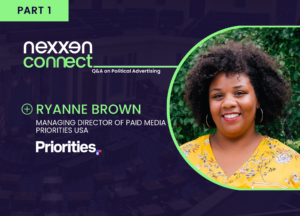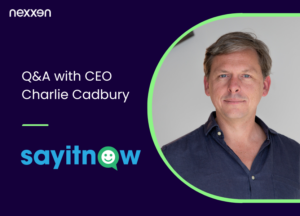

Nexxen Connect: Q&A on Political Advertising with Ryanne Brown – Part 2
Read part 1 of our discussion with Ryanne Brown, Managing Director of Paid Media at Priorities USA.
Ryanne Brown has more than 14 years of experience working with a variety of Democratic campaigns, nonprofits, advocacy groups and ballot initiatives. She is currently the Managing Director of Paid Media at Priorities USA where she oversees all paid and organic media programs. Prior to joining Priorities, she served as the Managing Director at Do Big Things and the Deputy Digital Advertising Director at 270 Strategies where she worked with clients including Cory Booker 2020, Amy McGrath for Senate, Lauren Underwood for Congress, Community Change, NBCUniversal, BlackPAC, Supermajority and Rock the Vote. Ryanne is a Chicago native and a graduate of Marquette University.

Ryanne Brown
Managing Director of Paid Media, Priorities USA
In your research, is contextual targeting more impactful among certain voter groups or demographics than others?
If you do your job right, the answer can be yes among certain groups. And I say that because certain demographics and certain groups’ subcultures are really strong. And if you are tapped into that, then yes, contextual targeting can be your best friend. But if you’re not going to be intentional about using it, then no, you’re probably going to need other targeting tactics to help fill out your strategy.
For the research project that you guys concluded with last year, are you at the point where you have first results that you’re able to share or is that ongoing?
Sure! We did a couple of contextual targeting experiments on YouTube last summer, and it’s something we’re going to continue to do. In one of the experiments, we took a couple of channel clusters – like self help, cooking, and Black cultural affinity, and AAPI affinity. Using just the clusters and no other targeting besides geographic, we ran a program and complemented it with a Brand Lift study to see if there was any lift. And what we found was that, yes – across the board we found lift across each of these buckets –with the highest lift in the AAPI and Black cultural affinity channel clusters.
The other thing that we were able to find is that there’s a ton of scale. Because of that, we’re ramping up to do the second rounds of these tests to understand how we can find efficiencies within these large channel clusters. What we saw in the Black and AAPI clusters, for example, music was really, really big in both of those groups.
Last summer, we ran a different sort of test in Arizona. In our work to reelect Senator Mark Kelly, we ran ads on the right-wing channels of YouTube, and we found almost a 10 point lift in people’s ability to be persuaded on YouTube. So someone would be watching Fox News, Ben Shapiro or Candace Owens for example, they would immediately view one of our ads, and we saw that their ability to be persuaded shot way up.
So there’s a ton of possibility with contextual targeting that honestly we’re just scratching the surface of.

Ryanne Brown
Managing Director of Paid Media, Priorities USA
Read part 1 of our discussion with Ryanne Brown, Managing Director of Paid Media at Priorities USA.
Ryanne Brown has more than 14 years of experience working with a variety of Democratic campaigns, nonprofits, advocacy groups and ballot initiatives. She is currently the Managing Director of Paid Media at Priorities USA where she oversees all paid and organic media programs. Prior to joining Priorities, she served as the Managing Director at Do Big Things and the Deputy Digital Advertising Director at 270 Strategies where she worked with clients including Cory Booker 2020, Amy McGrath for Senate, Lauren Underwood for Congress, Community Change, NBCUniversal, BlackPAC, Supermajority and Rock the Vote. Ryanne is a Chicago native and a graduate of Marquette University.
In your research, is contextual targeting more impactful among certain voter groups or demographics than others?
If you do your job right, the answer can be yes among certain groups. And I say that because certain demographics and certain groups’ subcultures are really strong. And if you are tapped into that, then yes, contextual targeting can be your best friend. But if you’re not going to be intentional about using it, then no, you’re probably going to need other targeting tactics to help fill out your strategy.
For the research project that you guys concluded with last year, are you at the point where you have first results that you’re able to share or is that ongoing?
Sure! We did a couple of contextual targeting experiments on YouTube last summer, and it’s something we’re going to continue to do. In one of the experiments, we took a couple of channel clusters – like self help, cooking, and Black cultural affinity, and AAPI affinity. Using just the clusters and no other targeting besides geographic, we ran a program and complemented it with a Brand Lift study to see if there was any lift. And what we found was that, yes – across the board we found lift across each of these buckets –with the highest lift in the AAPI and Black cultural affinity channel clusters
The other thing that we were able to find is that there’s a ton of scale. Because of that, we’re ramping up to do the second rounds of these tests to understand how we can find efficiencies within these large channel clusters. What we saw in the Black and AAPI clusters, for example, music was really, really big in both of those groups.
Last summer, we ran a different sort of test in Arizona. In our work to reelect Senator Mark Kelly, we ran ads on the right-wing channels of YouTube, and we found almost a 10 point lift in people’s ability to be persuaded on YouTube. So someone would be watching Fox News, Ben Shapiro or Candace Owens for example, they would immediately view one of our ads, and we saw that their ability to be persuaded shot way up.
So there’s a ton of possibility with contextual targeting that honestly we’re just scratching the surface of.
At the end of the day for every advertiser, your goal is to be where your people are on the internet ... So we work with folks like Nexxen to make sure we're monitoring campaigns, making those optimizations within the campaign, and ultimately going where we're seeing people go.
At the end of the day for every advertiser, your goal is to be where your people are on the internet ... So we work with folks like Nexxen to make sure we're monitoring campaigns, making those optimizations within the campaign, and ultimately going where we're seeing people go.
Just curious – were there any groups that definitely didn’t work?
Finance resulted in the lowest lift, which we thought was interesting too. We plan to dive in further on that one because finance can be defined in many ways.
How do you measure the effectiveness of contextual vs. other strategies, and which KPIs are most relevant? You mentioned brand lift as the most common – are there any other ways?
Yeah, I would say Brand Lift is the main way that we do it – a control/exposed environment.
To measure the effectiveness of contextual at a very basic level on another platform without a measurement tool, I’d compare a bunch of different targeting tactics in the plan and see which one we’re getting the most reach, frequency, where you get the most engagement, etc. Let me just say that those measurements are a surface level, but it is some indication of whether of what kind of targeting tactics are more relevant and 9 times out of 10 I bet that contextual will be the one that will rise to the top.
In delivering to contextual audiences – which is more important: defining the correct terms and phrases that will capture your target audience up front, or being flexible mid-flight to dynamically add and remove certain terms and phrases?
It’s both. Because at the end of the day for every advertiser, your goal is to be where your people are on the internet. It is your job on the front end to do your due diligence to best define what you think that audience is, but you also need to be watching your campaign to see for example – “oh something’s not working, we need to make optimizations,” to make sure that you’re getting the most out of that campaign. So we work with folks like Nexxen to make sure we’re monitoring campaigns, making those optimizations within the campaign, and ultimately going where we’re seeing people go on the Internet.
Does the frequency of term exposure (i.e. consumes the term once, vs. consumes it daily) tell us anything about an individual or how relevant they could be for our target audience?
We pay more attention to the folks who are consistently going back to it, and what we find is that it’s obviously a smaller group of people but we’re trying to understand how important/how persuasive that group is on its own, until they grow to affect a larger audience. I worry less about the people who look at a topic once, but we do look at frequency over various lengths of time so if someone is listening to a podcast once vs. once per week – that’s worth paying attention to. But if it’s once per month, I’m not as worried.
What do you predict you’ll use more this cycle – contextual targeting or contextual suppression?
Interesting question, We’ll probably end up using both – 50/50, I’d say – depending on which state we’re in. It might be more relevant to do suppression in a place like Wisconsin, which is super red outside of Milwaukee. But less relevant in a place like Michigan where our audiences tend to be more spread out throughout the state.
I think I’ve mentioned our Margins Project, where we’re trying to focus on voters who are persuadable and live outside the traditional democratic strongholds aka large cities. To that end, Priorities will be targeting mixed to potentially even redder areas depending on the state, so being able to use proactive targeting and suppression will be important to us, depending on the state and audience.
Could you give us a bit more info on how you define and target that “outcast” group?
How we arrived at “The Margins Project” was through research. We see that Republicans traditionally employ a broadcast targeting approach – statewide, targeting everyone.
On the Democratic side, we tend to narrowcast, focusing on where voters historically are and in more densely populated cities or DMAs, therefore leaving some parts of the state and a big swath of voters on the table. What we found in our research is that there are a ton of persuadable people in between those two strategies. In 2022, we found that 84% of Republican campaigns targeted voters on a statewide scale vs. 42% of Democratic campaigns. What we’ve also learned digging deeper into these audiences – their support score is 10 points lower than those that live in traditionally Democratic areas. So targeting a young person that lives at home with their parents is a different mindset than a young person who lives on campus at a university. Young voters, Black voters, Latino voters are our main audiences and where we’ll spend the bulk of our resources. People who have been left out or not considered until the very last minute, are the “margins” that we are talking about and want to focus on intentionally and early.
People who have been left out or not considered until the very last minute, are the “margins” that we are talking about and we want to focus on intentionally and early.
People who have been left out or not considered until the very last minute, are the “margins” that we are talking about and we want to focus on intentionally and early.
Which 3 contextual search phrases, when “and”-ed together, could an advertiser use to most easily distinguish Ryanne Brown from 330M other Americans?
I’m going to go with hair care products, Maroon 5, beach life.
This August the DNC is hosting its Convention in your home city. What are the best things about Chicago in Summer?
Summertime Chi – literally nothing can beat it. You will not come to another part of the country where you’ll meet people as happy as us just because the sun is shining. The lake, dining outside, the festivals, we love it all.
For all the Convention visitors that are going to descend on Chicago, what restaurants or bars would you recommend?
There’s this really good restaurant in Hyde Park called Virtue – owned by chef Erick Williams, who is a James Beard Award winner. As for a bar, anything in the West Loop you’ll find a vibe made just for you. There’s this one street called Randolph – many famous chefs have a restaurant on that street.
What is your election night celebration tradition?
If I’m in Chicago, I will have a glass (or bottle) of wine, and popcorn, as an ode to Olivia Pope.
And if I’m in DC – I’ll be at some election party not drinking, because I’m too nervous for election results.
Read Next
Connect With Us
Learn how you can effectively and meaningfully leverage today’s video and CTV opportunities with our end-to-end platform, data and insights.


